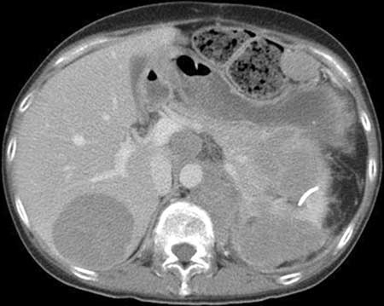Aetiology
Cushing syndrome may be caused by exogenous exposure, or endogenous causes, which are either adrenocorticotrophic hormone (ACTH)-dependent or ACTH-independent. No specific exposures or modifiable factors have been identified that cause endogenous hypercortisolism. The aetiology of pituitary overproduction of ACTH and adrenal adenoma overproduction of cortisol is poorly understood.
Exogenous exposure
Exogenous corticosteroid exposure is the most common cause of Cushing syndrome. Patients taking exogenous corticosteroids for any reason may develop features of Cushing syndrome. When high-dose glucocorticosteroids are stopped, patients can develop adrenal insufficiency despite a clinical phenotype of Cushing syndrome.
ACTH-dependent Cushing syndrome
Caused by conditions that have high or inappropriately normal ACTH levels stimulating adrenal cortisol overproduction. ACTH-secreting pituitary adenomas (Cushing's disease) and ectopic ACTH-secreting tumours are two forms of ACTH-dependent disease. The majority (70% to 80%) of patients with endogenous Cushing syndrome have ACTH-secreting pituitary adenomas; however, only 10% of all pituitary adenomas secrete excessive ACTH.[3][11] Ectopic ACTH-secreting tumours are typically of bronchogenic or neuroendocrine origin.[2] Ectopic corticotropin-releasing hormone syndrome can also be considered in this category, but is extremely rare.
Silent corticotroph adenomas are immunopositive for ACTH, but clinically present as non-functioning adenomas. However, large adenomas can rarely become ACTH-secreting and cause Cushing's disease.[12] A new gene, ubiquitin-specific protease 8, has been found to be frequently mutated in Cushing's disease.[13]
ACTH-independent
Caused by excessive cortisol secretion by the adrenal glands despite a suppressed ACTH level. Included in this category are adrenal adenomas, bilateral adrenal hyperplasia, and, rarely, adrenal carcinoma. About 10% of patients with endogenous Cushing syndrome have adrenal adenomas with unregulated secretion of cortisol, but only 5% of all adrenal adenomas develop autonomous cortisol secretion.[3][9] Mutations in the cAMP/PKA pathway are the cause of most cases of primary adrenal hypercortisolism.[14]
Only about 1% of patients with Cushing syndrome have adrenal carcinoma; it typically presents as a large (>5 cm) and rapidly growing adrenal mass. However, adrenal overproduction of cortisol is seen in 50% to 60% of adrenal carcinomas.[5][Figure caption and citation for the preceding image starts]: Abdominal computed scan showing adrenocortical tumour infiltrating the pancreas and left kidney, and metastasised to the liver, spleen, and central nodesFrom BMJ Case Reports 2010; doi:10.1136/bcr.07.2009.2100 [Citation ends].
Pathophysiology
The clinical manifestations result from excess tissue exposure to cortisol. The degree to which symptoms manifest is largely, if not entirely, based on the degree of cortisol excess. Patients with mild to moderate hypercortisolism generally have a less prominent phenotype with glucose intolerance, dyslipidaemia, metabolic bone disease, and abnormal weight gain, but are difficult to differentiate from other patients with the metabolic syndrome. As the hypercortisolism increases, physical features worsen with striae, supraclavicular fat pads, and proximal muscle weakness developing. Ectopic adrenocorticotrophic hormone (ACTH) secretion from neuroendocrine tumours may manifest as more severe cases with the abrupt presentation of symptoms and greatly elevated cortisol and ACTH. These patients may also have severe muscle weakness and weight loss.
Use of this content is subject to our disclaimer